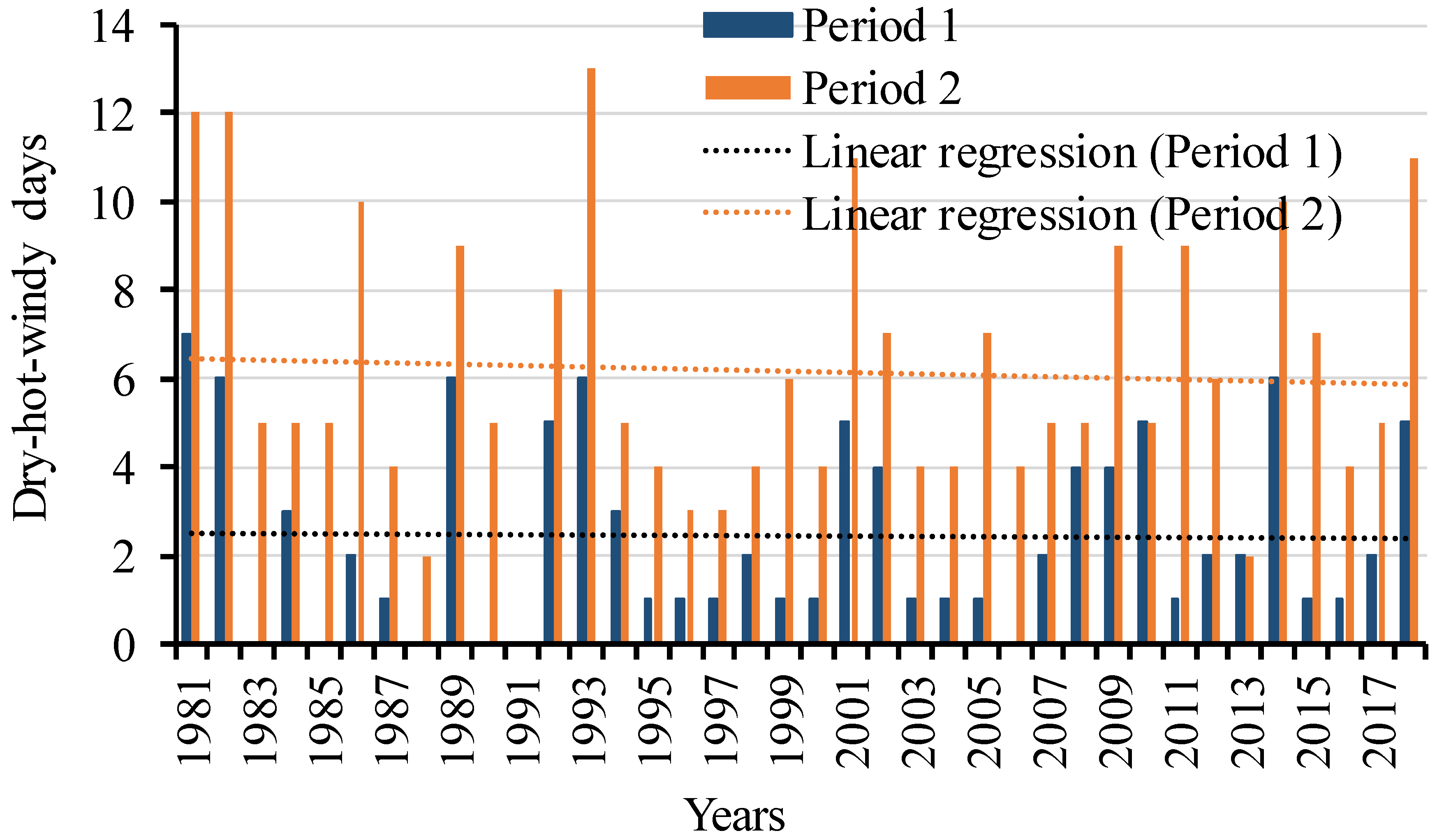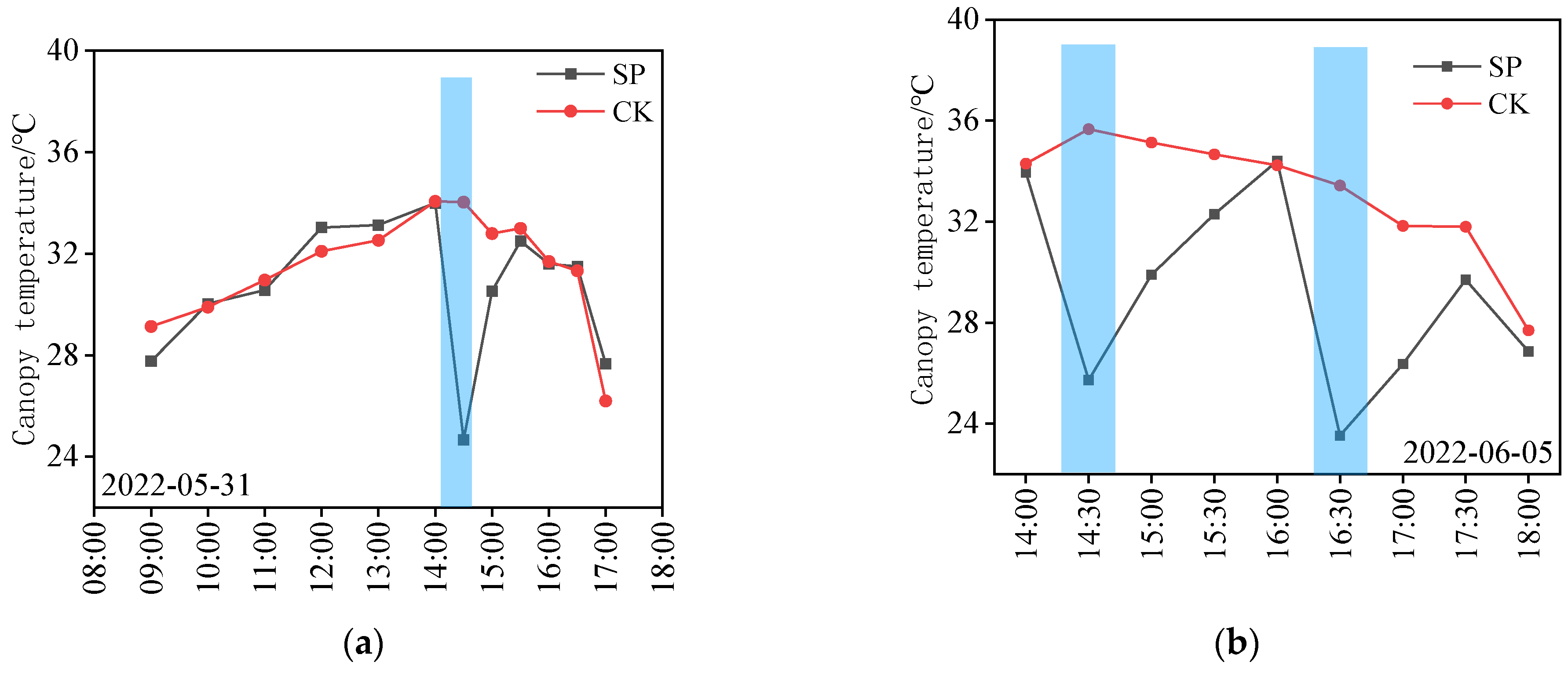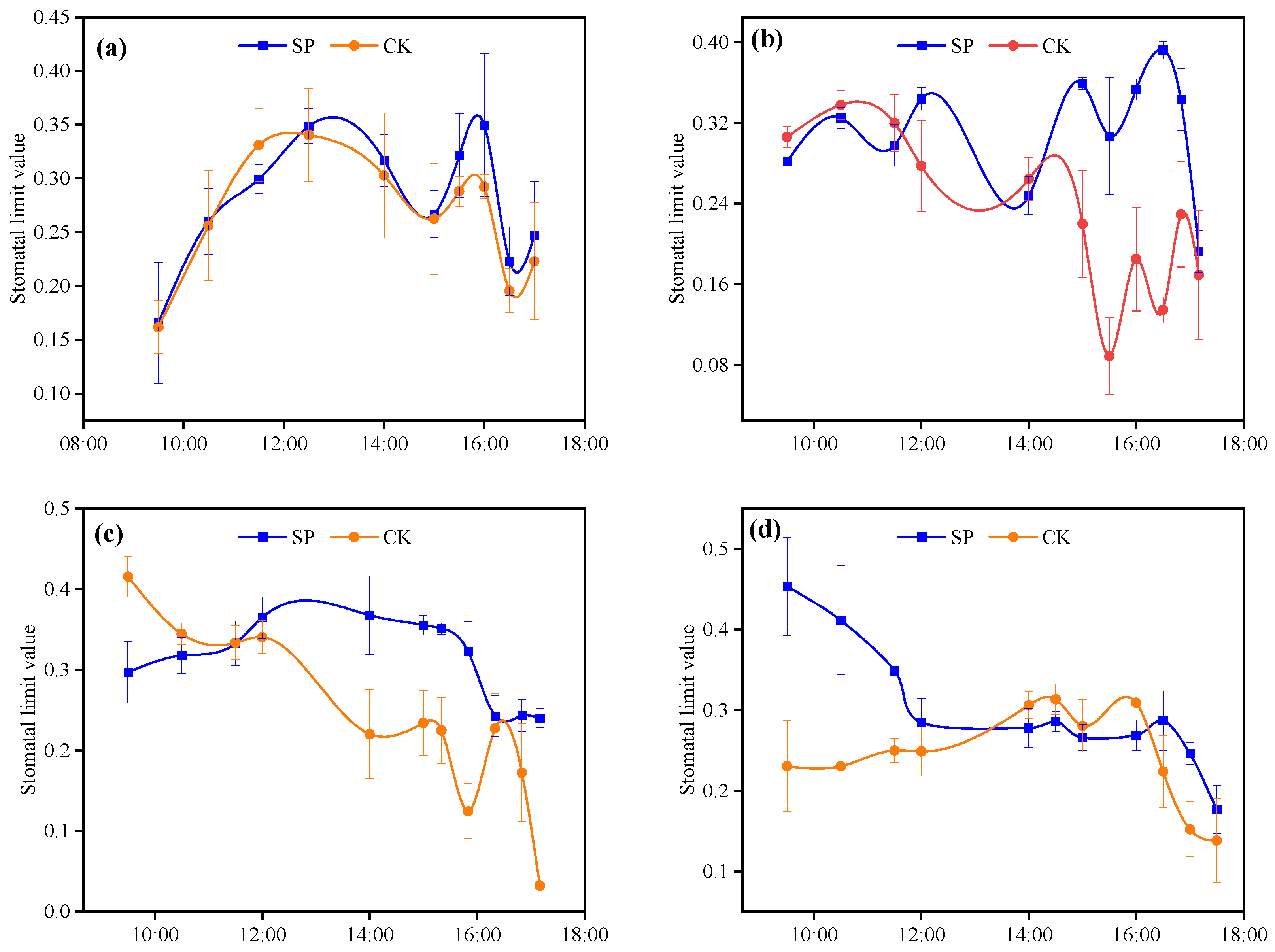Mitigating Dry–Hot–Windy Climate Disasters in Wheat Fields Using the Sprinkler Irrigation Method
Abstract
:1. Introduction
2. Materials and Methods
2.1. Experimental Site
2.2. Experimental Layout
2.3. Measurements
2.4. Data Processing
3. Results
3.1. Dry–Hot–Windy Climate in the Winter Wheat Season
3.2. Soil Water Content and Field Microclimate
3.3. Canopy Temperature Response to Spraying on DHW Days
3.4. Photosynthetic Trait Responses to Spraying on DHW Days
3.5. Response of the Grain-Filling Process and Yield to Spraying on DHW Days
4. Discussion
4.1. Microclimate Changes Caused by Spraying Water on DHW Days
4.2. Improvements in Photosynthesis Traits and Yield Caused by Spraying Water on DHW Days
4.3. Spraying Time and Amount of Water on DHW Days
5. Conclusions
- (1)
- Spraying water during dry–hot–windy climate conditions could significantly improve field microclimate by decreasing air temperature and increasing humidity during spraying period and approximately 60 min after spraying.
- (2)
- The improved field microclimate enhanced the photosynthesis and transpiration rates and the stomatal conductivity, which consequently increase the grain-filling rate and finally the wheat yield.
- (3)
- One spraying event could be enough to mitigate the high temperature and low humidity on most dry–hot–windy days, and two spraying events are recommended when the intensity of the dry–hot–windy climate is strong. An irrigation water depth of 2–2.5 mm each time is sufficient to wet the wheat canopy with an LAI of 4–5.
Author Contributions
Funding
Data Availability Statement
Acknowledgments
Conflicts of Interest
References
- National Bureau of Statistics of China. National Statistics Yearbook; China Statistics Press: Beijing, China, 2023.
- Rezaei, E.E.; Webber, H.; Asseng, S.; Boote, K.; Durand, J.L.; Ewert, F.; Martre, P.; MacCarthy, D.S. Climate change impacts on crop yields. Nat. Rev. Earth Environ. 2023, 4, 831–846. [Google Scholar] [CrossRef]
- Ishaque, W.; Osman, R.; Hafiza, B.S.; Malghani, S.; Zhao, B.; Xu, M.; Ata-Ul-Karim, S.T. Quantifying the impacts of climate change on wheat phenology, yield, and evapotranspiration under irrigated and rainfed conditions. Agric. Water Manag. 2023, 275, 108017. [Google Scholar] [CrossRef]
- Bai, H.; Xiao, D.; Tang, J.; Liu, D.L. Evaluation of wheat yield in North China Plain under extreme climate by coupling crop model with machine learning. Comput. Electron. Agric. 2024, 217, 108651. [Google Scholar] [CrossRef]
- QX/T 82-2019; Disaster Grade of Dry-Hot Wind for Wheat. Chinese Academy of Meteorological Sciences: Beijing, China, 2019.
- Feng, Y.; Sun, F.; Wang, H.; Liu, F. Recent warm-season dryness/wetness dominated by hot-dry wind in Northern China. J. Hydrol. 2023, 627, 130436. [Google Scholar] [CrossRef]
- Zahra, N.; Hafeez, M.B.; Ghaffar, A.; Kausar, A.; Zeidi, M.A.; Siddique, K.H.M.; Farooq, M. Plant photosynthesis under heat stress: Effects and management. Environ. Exp. Bot. 2023, 206, 105178. [Google Scholar] [CrossRef]
- Zhao, H.; Zhang, L.; Kirkham, M.B.; Welch, S.M.; Nielsen-Gammon, J.W.; Bai, G.; Luo, J.; Andresen, D.A.; Rice, C.W.; Wan, N.; et al. U.S. winter wheat yield loss attributed to compound hot-dry-windy events. Nat. Commun. 2022, 13, 7233. [Google Scholar] [CrossRef]
- Tang, X. Mechanism of Sprinkler Irrigation Scheduling and Wheat Varieties on Crop Evapotranspiration and Yield and Their Optimal Combination to Cope with Climate Change. Ph.D. Thesis, Beijing Normal University, Beijing, China, 2023. [Google Scholar]
- Yang, F.-H.; Bryla, D.R.; Peters, R.T. An Energy balance model for predicting berry temperature and scheduling sprinklers for cooling in northern highbush blueberry. HortScience 2021, 56, 447–453. [Google Scholar] [CrossRef]
- Wang, Y.; Li, M.; Hui, X.; Meng, Y.; Yan, H. Alfalfa canopy water interception under low-pressure sprinklers. Agric. Water Manag. 2020, 230, 105919. [Google Scholar] [CrossRef]
- Yang, F.-H.; Bryla, D.R.; Orr, S.T.; Strik, B.C.; Zhao, Y. Thermal cooling with sprinklers or microsprinklers reduces heat damage and improves fruit quality in northern highbush blueberry. HortScience 2020, 55, 1365–1371. [Google Scholar] [CrossRef]
- Uddin, M.J.; Murphy, S.R. Evaporation losses and evapotranspiration dynamics in overhead sprinkler irrigation. J. Irrig. Drain. Eng. 2020, 146, 04020023. [Google Scholar] [CrossRef]
- Baifus Manke, E.; Nörenberg, B.G.; Faria, L.C.; Tarjuelo, J.M.; Colombo, A.; Chagas Neta, M.C.C.; Parfitt, J.M.B. Wind drift and evaporation losses of a mechanical lateral-move irrigation system: Oscillating plate versus fixed spray plate sprinklers. Agric. Water Manag. 2019, 225, 105759. [Google Scholar] [CrossRef]
- Tang, X.; Liu, H.; Yang, L.; Li, L.; Chang, J. Energy balance, microclimate, and crop evapotranspiration of winter wheat (Triticum aestivum L.) under sprinkler irrigation. Agriculture 2022, 12, 953. [Google Scholar] [CrossRef]
- Urrego-Pereira, Y.; Cavero, J.; Medina, E.T.; Martínez-Cob, A. Role of transpiration reduction during center-pivot sprinkler irrigation in application efficiency. J. Irrig. Drain. Eng. 2013, 139, 221–232. [Google Scholar] [CrossRef]
- Urrego-Pereira, Y.F.; Martínez-Cob, A.; Fernández, V.; Cavero, J. Daytime sprinkler irrigation effects on net photosynthesis of maize and alfalfa. Agron. J. 2013, 105, 1515–1528. [Google Scholar] [CrossRef]
- Cai, D.; Shoukat, M.R.; Zheng, Y.; Tan, H.; Meng, F.; Yan, H. Optimizing center pivot irrigation to regulate field microclimate and wheat physiology under dry-hot wind conditions in the North China Plain. Water 2022, 14, 708. [Google Scholar] [CrossRef]
- Liu, H.; Kang, Y. Effect of sprinkler irrigation on microclimate in the winter wheat field in the North China Plain. Agric. Water Manag. 2006, 84, 3–19. [Google Scholar] [CrossRef]
- Liu, H.; Kang, Y.; Yao, S.M.; Sun, Z.Q.; Liu, S.P.; Wang, Q.G. Field evaluation on water productivity of winter wheat under sprinkler or surface irrigation in the north china plain. Irrig. Drain. 2013, 62, 37–49. [Google Scholar] [CrossRef]
- Zhao, W.; Li, J.; Li, Y. Modeling sprinkler efficiency with consideration of microclimate modification effects. Agric. For. Meteorol. 2012, 161, 116–122. [Google Scholar] [CrossRef]
- Martínez-Cob, A.; Playán, E.; Zapata, N.; Cavero, J.; Medina, E.T.; Puig, M. Contribution of evapotranspiration reduction during sprinkler irrigation to application efficiency. J. Irrig. Drain. Eng. 2008, 134, 745–756. [Google Scholar] [CrossRef]
- Liu, Z.; Jiao, X.; Zhu, C.; Katul, G.G.; Ma, J.; Guo, W. Micro-climatic and crop responses to micro-sprinkler irrigation. Agric. Water Manag. 2021, 243, 106498. [Google Scholar] [CrossRef]
- Liu, H.; Kang, Y. Regulating field microclimate using sprinkler misting under hot-dry windy conditions. Biosyst. Eng. 2006, 95, 349–358. [Google Scholar] [CrossRef]
- Wang, Q.; Kang, Y.; Liu, H.; Liu, S. Method for measurement of canopy interception under sprinkler irrigation. J. Irrig. Drain. Eng. 2006, 132, 185–187. [Google Scholar] [CrossRef]
- Liu, H.; Chang, J.; Tang, X.; Zhang, J. In situ measurement of stemflow, throughfall and canopy interception of sprinkler irrigation water in a wheat field. Agriculture 2022, 12, 1265. [Google Scholar] [CrossRef]
- Ministry of Construction of the People’s Republic. Technical Code for Sprinkler Irrigation; Ministry of Construction of the People’s Republic: Beijing, China, 2007. [Google Scholar]
- Song, X.; Zhou, G.; He, Q.; Zhou, H. Stomatal limitations to photosynthesis and their critical Water conditions in different growth stages of maize under water stress. Agric. Water Manag. 2020, 241, 106330. [Google Scholar] [CrossRef]
- Aspinwall, M.J.; Faciane, M.; Harris, K.; O’Toole, M.; Neece, A.; Jerome, V.; Colón, M.; Chieppa, J.; Feller, I.C. Salinity has little effect on photosynthetic and respiratory responses to seasonal temperature changes in black mangrove (Avicennia germinans) seedlings. Tree Physiol. 2021, 41, 103–118. [Google Scholar] [CrossRef]
- Pei, D.; Sun, Z.; Chen, S.; Zhang, X.; Chen, S.; Wang, Z. Effects of water stress on physiological and agronomic features of winter wheat. Trans. Chin. Soc. Agric. Eng. 2006, 22, 68–72. [Google Scholar]
- Zhang, X.; Pei, D.; Hu, C. Index system for irrigation scheduling of winter wheater and maize in the piedmont of Mountain Taihang. Trans. Chin. Soc. Agric. Eng. 2002, 18, 36–41. [Google Scholar]
- Schauberger, B.; Archontoulis, S.; Arneth, A.; Balkovic, J.; Ciais, P.; Deryng, D.; Elliott, J.; Folberth, C.; Khabarov, N.; Müller, C.; et al. Consistent negative response of US crops to high temperatures in observations and crop models. Nat. Commun. 2017, 8, 13931–13939. [Google Scholar] [CrossRef]
- Cavero, J.; Medina, E.T.; Montoya, F. Sprinkler irrigation frequency affects maize yield depending on irrigation time. Agron. J. 2018, 110, 1862–1873. [Google Scholar] [CrossRef]
- Tang, X.; Liu, H.; Zhang, W. Physiological characteristics, crop growth and grain yield of twelve wheat varieties cultivated in the North China Plain. Agronomy 2023, 13, 3041. [Google Scholar] [CrossRef]
- Verma, L.; Singh, A.K.; Singh, S.; Tiwari, D.; Zaidi, S.T.; Yadav, R.K.; Mishra, S.R.; Singh, A.K. Temperature stress its impact on yield of various wheat varieties at different growth stages. Natl. Acad. Sci. Lett. 2024, 47, 219–225. [Google Scholar] [CrossRef]
- Khan, A.; Ahmad, M.; Ahmed, M.; Iftikhar Hussain, M. Rising atmospheric temperature impact on wheat and thermotolerance strategies. Plants 2021, 10, 43. [Google Scholar] [CrossRef]
- Shah, N.H.; Paulsen, G.M. Interaction of drought and high temperature on photosynthesis and grain-filling of wheat. Plant Soil 2003, 257, 219–226. [Google Scholar] [CrossRef]
- Thapa, S.; Jessup, K.E.; Pradhan, G.P.; Rudd, J.C.; Liu, S.; Mahan, J.R.; Devkota, R.N.; Baker, J.A.; Xue, Q. Canopy temperature depression at grain filling correlates to winter wheat yield in the U.S. Southern High Plains. Field Crops Res. 2018, 217, 11–19. [Google Scholar] [CrossRef]
- Correia, P.M.P.; Cairo Westergaard, J.; da Silva, A.B.; Roitsch, T.; Carmo-Silva, E.; da Silva, J.M. High-throughput phenotyping of physiological traits for wheat resilience to high temperature and drought stress. J. Exp. Bot. 2022, 73, 5235–5251. [Google Scholar] [CrossRef]
- Mott, K.A.; Parkhurst, D.F. Stomatal responses to humidity in air and helox. Plant Cell Environ. 1991, 14, 509–515. [Google Scholar] [CrossRef]
- Mustafa, T.; Sattar, A.; Sher, A.; Ul-Allah, S.; Ijaz, M.; Irfan, M.; Butt, M.; Cheema, M. Exogenous application of silicon improves the performance of wheat under terminal heat stress by triggering physio-biochemical mechanisms. Sci. Rep. 2021, 11, 23170. [Google Scholar] [CrossRef]
- Ahammed, G.J.; Xu, W.; Liu, A.; Chen, S. COMT1 silencing aggravates heat stress-induced reduction in photosynthesis by decreasing chlorophyll content, photosystem II activity, and electron transport efficiency in tomato. Front. Plant Sci. 2018, 9, 998. [Google Scholar] [CrossRef]
- Ma, M.-Y.; Liu, Y.; Zhang, Y.-W.; Qin, W.-L.; Wang, Z.-M.; Zhang, Y.-H.; Lu, C.-M.; Lu, Q.-T. In situ measurements of winter wheat diurnal changes in photosynthesis and environmental factors reveal new insight into photosynthesis improvement by super-high-yield cultivation. J. Integr. Agric. 2021, 20, 527–539. [Google Scholar] [CrossRef]
- Wang, C.; Zhang, Y.; Zhang, J. Risk assessment of main meteorological disasters of winter wheat in North China. Trans. Chin. Soc. Agric. Eng. 2016, 32, 203–213. [Google Scholar]
- Mumtaz, R.; Maqsood, M.H.; Haq, I.u.; Shafi, U.; Mahmood, Z.; Mumtaz, M. Integrated digital image processing techniques and deep learning approaches for wheat stripe rust disease detection and grading. Decis. Anal. J. 2023, 8, 100305. [Google Scholar] [CrossRef]
- Baker, C.J.; Berry, P.M.; Spink, J.H.; Sylvester-Bradley, R.; Griffin, J.M.; Scott, R.K.; Clare, R.W. A method for the assessment of the risk of wheat lodging. J. Theor. Biol. 1998, 194, 587–603. [Google Scholar] [CrossRef]
- Kang, Y.; Wang, Q.-G.; Liu, H.-J. Winter wheat canopy interception and its influence factors under sprinkler irrigation. Agric. Water Manag. 2005, 74, 189–199. [Google Scholar] [CrossRef]













| Depth (cm) | Soil Particle Distribution (%) | Soil Texture | Bulk Density | Field Capacity | Saturated Soil Water Content | ||
|---|---|---|---|---|---|---|---|
| Clay (<0.002 mm) | Silt (0.002–0.02 mm) | Sand (0.02–2 mm) | g/cm3 | cm3/cm3 | cm3/cm3 | ||
| 0–20 | 12.5 | 66.8 | 20.7 | Silt loam | 1.40 | 0.34 | 0.41 |
| 20–40 | 12.1 | 68.1 | 19.8 | 1.43 | 0.36 | 0.41 | |
| 40–60 | 14.3 | 70.6 | 15.1 | 1.49 | 0.39 | 0.42 | |
| 60–80 | 16.9 | 64.6 | 18.5 | 1.48 | 0.40 | 0.44 | |
| 80–100 | 18.3 | 60.8 | 20.9 | 1.54 | 0.42 | 0.47 | |
| Climate Indicators | Seasons | 2019 | 2022 | |||
|---|---|---|---|---|---|---|
| DHW Day | 2 June | 28 May | 31 May | 3 June | 5 June | |
| Air temperature | °C | 36.81 | 33.42 | 36.48 | 37.64 | 36.50 |
| Relative humidity | % | 25.55 | 30.78 | 18.59 | 23.34 | 11.58 |
| Wind speed | m s−1 | 3.45 | 4.06 | 6.54 | 4.47 | 2.34 |
| Seasons | Spraying | No Spraying | ||
|---|---|---|---|---|
| Wheat Yield (kg ha−1) | CV | Wheat Yield (kg ha−1) | CV | |
| 2018–2019 | 8.63a | 0.019 | 8.54a | 0.016 |
| 2021–2022 | 9.37a | 0.018 | 9.29a | 0.025 |
Disclaimer/Publisher’s Note: The statements, opinions and data contained in all publications are solely those of the individual author(s) and contributor(s) and not of MDPI and/or the editor(s). MDPI and/or the editor(s) disclaim responsibility for any injury to people or property resulting from any ideas, methods, instructions or products referred to in the content. |
© 2024 by the authors. Licensee MDPI, Basel, Switzerland. This article is an open access article distributed under the terms and conditions of the Creative Commons Attribution (CC BY) license (https://creativecommons.org/licenses/by/4.0/).
Share and Cite
Liu, H.; Ren, Y.; Zhou, X.; Liu, R. Mitigating Dry–Hot–Windy Climate Disasters in Wheat Fields Using the Sprinkler Irrigation Method. Agronomy 2024, 14, 1962. https://doi.org/10.3390/agronomy14091962
Liu H, Ren Y, Zhou X, Liu R. Mitigating Dry–Hot–Windy Climate Disasters in Wheat Fields Using the Sprinkler Irrigation Method. Agronomy. 2024; 14(9):1962. https://doi.org/10.3390/agronomy14091962
Chicago/Turabian StyleLiu, Haijun, Yuhui Ren, Xueqing Zhou, and Ronghao Liu. 2024. "Mitigating Dry–Hot–Windy Climate Disasters in Wheat Fields Using the Sprinkler Irrigation Method" Agronomy 14, no. 9: 1962. https://doi.org/10.3390/agronomy14091962
APA StyleLiu, H., Ren, Y., Zhou, X., & Liu, R. (2024). Mitigating Dry–Hot–Windy Climate Disasters in Wheat Fields Using the Sprinkler Irrigation Method. Agronomy, 14(9), 1962. https://doi.org/10.3390/agronomy14091962







